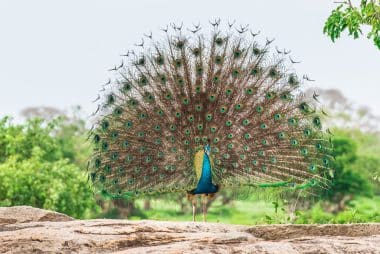If you visit the island of Sri Lanka in the Indian Ocean, you should not miss the Yala National Park. It is the oldest and most famous nature reserve on the island. Yala National Park is around 1,500 square kilometres in size and is located in the south of Sri Lanka in the province of Uva. The park has a rich tropical flora and fauna to offer. Above all, many rare mammal and bird species are represented there. Below you can find out more about Yala National Park.
History and structure of the national park
Since the In the 2nd century, the area of today’s Yala National Park is inhabited by Buddhist monks. Since it was under the dominion of the Kingdom of Ruhuna, it is also known as the Ruhuna National Park. The area was placed under nature conservation as early as 1899 and declared a national park in 1938. This applies to Block 1, which is open to tourists. The park was expanded by 1973 and four more blocks, which are usually not open to the public. This also applies to the nature reserve along the coast. In the public part of the national park there are restaurants and bungalows for tourists.
The vegetation
Large parts of the national park are filled with a savannah landscape. The flat thorn bush savannah is occasionally interrupted by towering rock formations called elephant rocks. The edge of the park, on the other hand, is characterized by dense monsoon forests. They are fed with water by the Menik Ganga and Kumbukkan Oya rivers. In many places, ponds and small lakes are forming. Both rivers flow through the plain and flow into the Indian Ocean. The densely overgrown coastal strip of the park has numerous lagoons. The Kumana Mangrave Swamp also stretches along the coast. In the wake of the rainy season, numerous climbing plants and wildflowers develop there. The different tree species in the park, such as halmilla, kumbuk and palu, provide food and shelter for many wild animals.
The Wildlife

Yala National Park is home to over 130 species of birds and 30 different species of mammals. This includes a small population of around 30 leopards. In addition, herds of elephants roam the park. In the plains and forests, you can also meet sloth bears looking for termites. Many native bird species live along the coast, but in the winter months also migratory birds from Europe, the West Indies and North India. Mammals in the park include golden jackal, cervical mongoose, axis deer, sambar deer and Ceylon hat monkey.
Birds and reptiles
Yala National Park makes it possible to see rare birds and reptiles in the wild. The park is home to the swamp crocodile, the light tiger python and the Bengal monitor lizard, among others. A special experience is also the observation of colorful and diverse bird species, such as Malabar hornbill, blue peacock, colored stork, red-faced Malkoha and Baugesicht Malkoha.
Temples and Aborigines
In Yala National Park you can visit several temple ruins. Up to 12,000 Buddhist monks are said to have lived in the temples of Situlpahuwa and in adjacent rock caves. Ruined cities worth seeing are also Magulmahavihara, Thalaguluhela Akashachetiya and Mayagala. To the north is the pilgrimage city of Kataragama. Every year, around 400,000 pilgrims cross the western part of the national park on their way there.
Tips for tourists
Visitors should note that Yala National Park is closed between August and October due to the dry season. The optimal time of year to visit is between December and May. The best way to reach the park is from Tissamaharama. The Yala National Park has a well-developed network of trails of 100 kilometers to offer. The circular trails pass important feeding and watering holes. In the national park, only guided tours with a jeep are possible. Bungalows are available on the park grounds for overnight stays.


